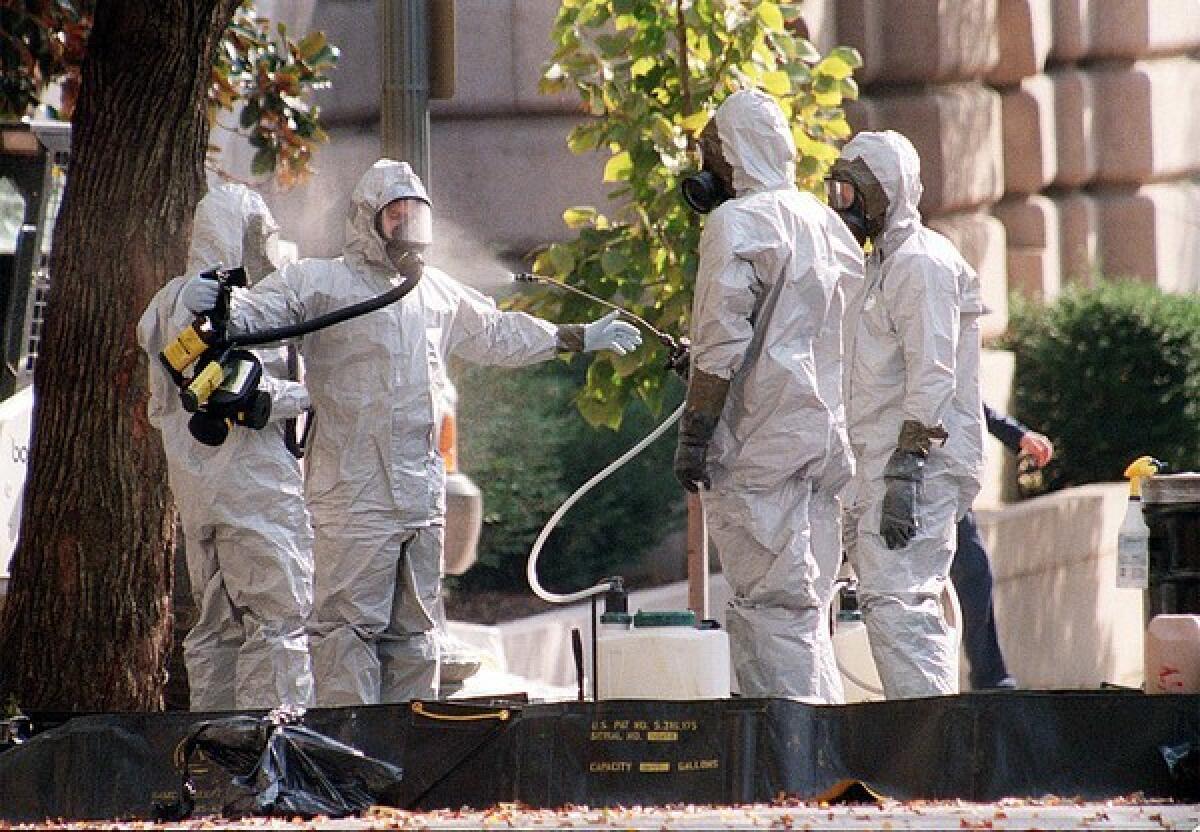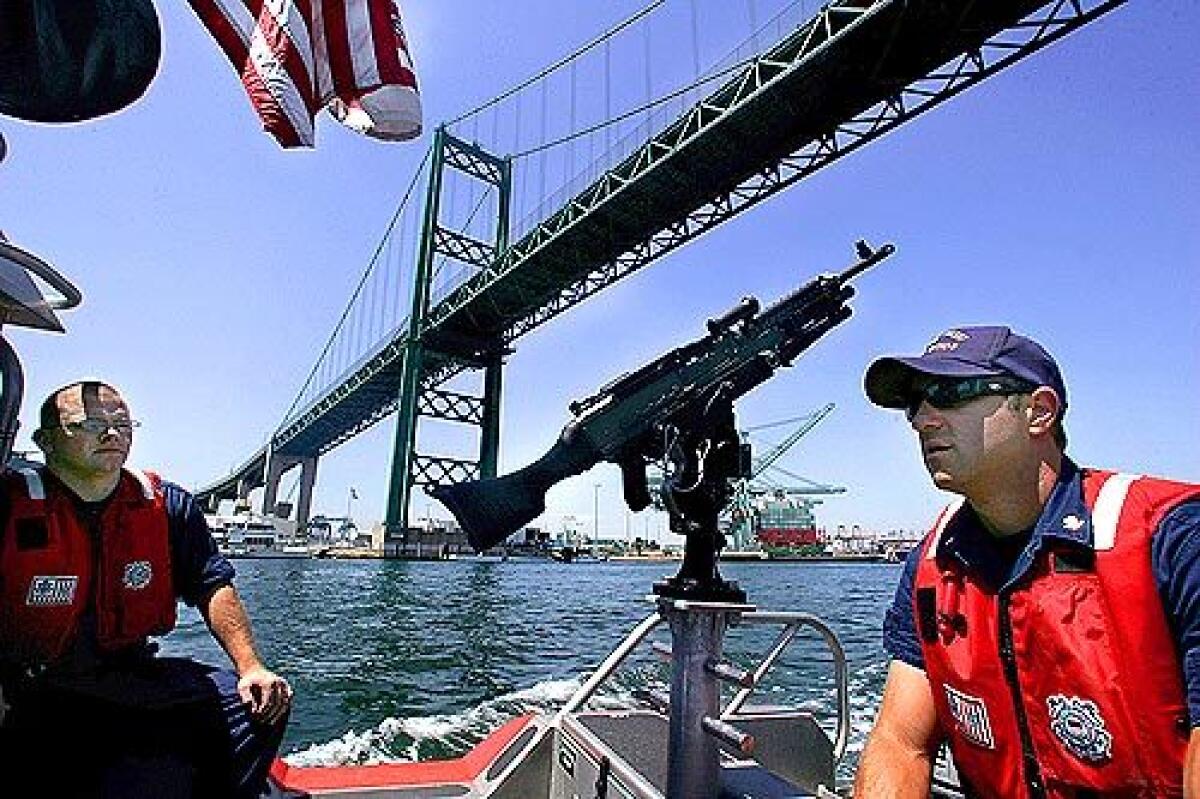Trump administration has gutted programs aimed at detecting weapons of mass destruction

- Share via
WASHINGTON — The Trump administration has quietly dismantled or cut back multiple programs that were created after the Sept. 11, 2001, attacks to help detect and prevent terrorism involving weapons of mass destruction, a Times investigation has found.
The retreat has taken place over the last two years at the Department of Homeland Security, which has primary domestic responsibility for helping authorities identify and block potential chemical, biological, radiological and nuclear threats.
The changes, not previously reported, were made without rigorous review of potential security vulnerabilities, The Times found, undermining government-wide efforts aimed at countering terrorist attacks involving unconventional weapons, known as weapons of mass destruction.
More than 30 current and former Homeland Security employees and contractors voiced concern that the changes — including the cancellation of dozens of training exercises and the departure of scores of scientists and policy experts — have put Americans at greater risk.
“What we had done in the past was analytically based: Where are the threats? Where can we get the most return on the taxpayers’ investment for security?” said Paul Ryan, who until mid-2017 helped lead Homeland Security’s Domestic Nuclear Detection Office, which was merged with another office last year.
“We’re not as secure as we were 18 months ago,” said Ryan, a retired Navy rear admiral.
The cutbacks and shifts have been directed by James F. McDonnell, who has been appointed by President Trump to successive posts at Homeland Security, a long-troubled department that has seen waves of leadership changes and policy upheaval since 2017.
McDonnell declined through a Homeland Security spokeswoman to be interviewed for this report, and the department did not answer written questions submitted on June 27.
On July 15, the spokeswoman, Ruth Clemens, emailed a three-sentence statement, saying that the Countering Weapons of Mass Destruction Office, which McDonnell heads, “is focused on preventing WMD terrorism by working with federal, state, and local partners across the nation.”
It also said, “some programs were realigned or restructured to better address threats, remove bureaucratic redundancy, and fully align with [Trump’s] National Security Strategy.”
Trump pledged in that 2017 document to “augment measures to secure, eliminate, and prevent the spread of WMD and related materials … to reduce the chance that they might fall into the hands of hostile actors.”
Among the programs gutted since 2017, however, was an elite Homeland Security “red team,” whose specialists conducted dozens of drills and assessments around the country each year to help federal, state and local officials detect such potential threats as an improvised nuclear device concealed in a suitcase, or a cargo ship carrying a radiation-spewing “dirty bomb.”
Another Homeland Security unit, the Operations Support Directorate, had helped lead up to 20 WMD-related training exercises each year with state and local authorities. The directorate participated in fewer than 10 such exercises last year and even fewer so far this year, according to internal Homeland Security documents.
Experts at Homeland Security’s National Technical Nuclear Forensics Center had worked with counterparts throughout the federal government to strengthen detection and tracing capabilities that might deter a hostile foreign state from slipping radiological or nuclear material to terrorists.
The center has been reduced to a shell: Its leadership is out and its staff has shrunk to three positions from about 14.
A separate Homeland Security component, the International Cooperation Division, which worked closely with foreign counterparts and the United Nations nuclear watchdog agency to track and stop the smuggling of dangerous nuclear materials overseas, has been disbanded.
Also cut back was the use of specialized, mobile detection units to help protect large public events from nuclear and radiological threats. The deployments have helped train local and state responders for a potential emergency.

For the first time in years, Homeland Security did not send a unit to protect the NCAA Final Four college basketball championship in April in Minneapolis or to an annual hot air balloon festival last fall in Albuquerque.
Homeland Security also has halted work to update a formal “strategic, integrated” assessment of chemical, biological and nuclear-related risks.
The assessment had previously analyzed millions of potential WMD threat scenarios. Under a directive President George W. Bush signed in 2007, the assessment is supposed to be updated at least every other year to provide objective guidance for the government’s purchases of detection-related technologies and medications for use following an attack.
“These risk assessments are how we stay ahead of the game,” said a former Homeland Security official, one of many who spoke on condition of anonymity for fear of losing a security clearance or other retaliation. “If we don’t keep updating those assessments, then we essentially lose the little bit of focus that we have on the problem and we really risk a strategic surprise.”
The risk assessments provide “an understanding of where to make investments that are targeted to reduce the risk of terrorism,” a current Homeland Security official added. If effective detection technologies are not put in place and if the right medications are not procured for the nation’s emergency stockpile, “that’s putting people at risk,” the official said.
Overall, more than 100 scientists and policy experts specializing in radiological and nuclear threats have been reassigned or left to take jobs unrelated to their expertise, The Times found, undermining the department’s ability to protect the nation from devastating attacks.
Similar turmoil has unfolded among those who had specialized in countering such biological threats as airborne spores of anthrax.
In the worst biological attack in U.S. history, letters laced with powdered anthrax spores were sent through the U.S. mail soon after the terrorist attacks of Sept. 11, 2001. Five Americans were killed and 17 others were infected. In July 2008, an Army scientist, Bruce E. Ivins, killed himself after he learned he was about to be indicted for the anthrax deaths.
Current and former Homeland Security officials warned in interviews that cutting back training around the country could erode readiness among those who would first confront a WMD terrorism attack.
“You keep the country safe by empowering state and local first responders who are out and about 24/7, 365 [days a year],” said one former Homeland Security official.
“The real thing could happen tomorrow with no warning,” another former official said. “And the only practice our defenders are going to have is through these ‘red team’ studies and actual exercises. That activity is necessary to ensure even basic competence.”
The changes have undermined the U.S. government’s multi-agency commitment since 2006 to build and maintain a “global nuclear detection architecture,” according to the present and former officials.
The goal, specified in legislation, was a layered network — from locations overseas to inside U.S. cities — to detect and assist the seizure of radiological or nuclear materials that could be wielded by terrorists.
McDonnell has become a formidable figure at the Department of Homeland Security since Trump named him director of the Domestic Nuclear Detection Office in early 2017. In May 2018, the president promoted him to be an assistant secretary of Homeland Security, heading the new Countering Weapons of Mass Destruction Office.
Trump signed the legislation that formally merged the Domestic Nuclear Detection Office, which was responsible for reducing the risk of radiological and nuclear terrorism, with the Office of Health Affairs, which had run BioWatch, the nation’s system for detecting potential airborne biological terrorism threats.
McDonnell has used broad discretion over the last two years to shift priorities and policies regarding WMD terrorism. Some of the changes are at odds with priorities authorized by formal presidential directives and by legislation enacted into law, The Times found.
The National Technical Nuclear Forensics Center, for example, was established in 2006 under Bush, and affirmed by legislation signed by President Obama in 2010, to help counter smuggling of nuclear materials that could be used in an attack. It has now been effectively gutted.
Separately, the presidential directive that Bush signed in 2007 required Homeland Security to update the integrated assessment of chemical, biological and nuclear-related risks “not less frequently than every two years.” The directive remains in force, along with two related mandates, but the update is incomplete and is more than two years overdue, The Times found.
Michael Grossman, who collaborated with Homeland Security specialists during his six years as chief of the Los Angeles County sheriff’s anti-terrorism section, said any slippage in attention to the WMD threat concerns him, in part because regaining readiness would take time.
“If you stay ready, you don’t have to get ready,” he said.
Current and former Homeland Security officials said they have struggled to grasp McDonnell’s rationale for cutting back training and other efforts intended to improve readiness, detection and tracing. They cited instances when specialists were removed from their areas of expertise in apparent retaliation for raising concerns about his policies.
Although the mobile detection units were deployed 70 or more times a year in response to requests from state and local officials, for example, McDonnell told subordinates he wants them used chiefly to support other Homeland Security operations and agencies, such as U.S. Customs and Border Protection and the Coast Guard.
Those agencies already have nuclear-detection equipment and procedures in place, according to congressional testimony and the Government Accountability Office, the investigative arm of Congress.
In 2016, Customs and Border Protection deployed specialized equipment to scan almost 100% of the cargo bound for and arriving at U.S. ports of entry, for example. It uses 1,400 giant radiation portal monitors to scan vehicles and cargo at land-border crossings, seaports, airports and mail facilities, the GAO reported that October.
Trump has repeatedly vowed to prevent terrorists from gaining access to unconventional weapons. In December, he said the “efforts will require close collaboration with and support to” the International Atomic Energy Agency, the U.N.’s nuclear watchdog agency, based in Vienna.
But McDonnell has disbanded the International Cooperation Division, which worked closely with the IAEA to help ensure dangerous nuclear material is seized overseas before it could be smuggled into the United States.
An IAEA official said “numerous” collaborations with Homeland Security over the years had bolstered nuclear security worldwide but that the joint efforts had come to a near-standstill.
“We hope that they would join in again,” said the official, who spoke on condition of anonymity because he was not authorized to comment publicly.
The Homeland Security division had participated in exercises with other IAEA member nations and helped generate “guidelines and best practices” that were adopted by 42 nations, according to one of McDonnell’s predecessors.
“This strategic partnership will continue to serve as a force multiplier for nuclear security efforts for years to come,” Huban A. Gowadia, then director of the Domestic Nuclear Detection Office, told the House Homeland Security Committee in February 2015.
To aid the collaborations, Homeland Security embedded a specialist at IAEA headquarters for several years. McDonnell eliminated the position.
Asked about the now-canceled position, an IAEA spokesman said in an email that the specialist had assisted member states “in strengthening their efforts to detect nuclear and radioactive material.”
Officials participating in a program known as Securing the Cities, which was intended as Homeland Security’s last layer of defense against radiological or nuclear terrorism, also have raised concerns.
Securing the Cities was supposed to fortify defenses in five major urban areas — greater Washington, D.C.; Los Angeles and Long Beach; New York City and nearby Newark, N.J.; Chicago; and Houston.
Overall, Homeland Security has provided the cities with training assistance and direct financial grants totaling about $145 million for detection equipment from 2007 to mid-2018. (The Los Angeles-Long Beach area was made part of Securing the Cities in 2012.)

But a GAO report dated May 13 described “confusion and uncertainty” among city officials participating in the program. According to the report, the chaotic circumstances have arisen, in part, because McDonnell has said he wants Homeland Security to reduce its participation and let other federal agencies play a larger role.
The GAO report said, however, that the agencies McDonnell had cited — the FBI and the National Nuclear Security Administration, part of the Energy Department — didn’t intend to do so.
Homeland Security officials told the GAO “that they have not conducted any studies or analyses that would justify making changes to the program,” the report states.
“We asked, `Why are you making changes and what are these changes going to look like?’” David Trimble, the supervising analyst for the report, recalled in an interview. “The details were very light. [Homeland Security] couldn’t really provide us a road map of where they were going. We found no analysis behind it.”
McDonnell’s overall objectives are unclear.
According to congressional budget experts, $162.2 million — about 40% of the money Congress appropriated last year for his office — went unspent. The unspent funds reflect indecision surrounding the shifted priorities and staff departures, current and former Homeland Security officials said.
On Dec. 18, dissatisfaction at the changes erupted at an “all-hands” staff meeting convened by McDonnell and attended by Kirstjen Nielsen, then-Homeland Security secretary, along with scores of subordinates from the Countering Weapons of Mass Destruction Office.
A supervisor, responsible for ensuring that operational expenditures are based on validated needs, stood and voiced concerns about McDonnell’s leadership and asked Nielsen to intervene, according to people who were in the room.
McDonnell sat silently and did not respond.
Soon after, Nielsen’s office instructed a personnel official, Sharon M. Wong, to conduct a “workplace climate assessment” to elicit opinions from current and recent staff members. Many of those who spoke with The Times said they also shared their misgivings with Wong.
One official said he had raised concerns about McDonnell’s efforts to install BioDetection 21, a controversial nationwide system intended to replace BioWatch for detecting airborne infectious agents such as anthrax. The replacement technology McDonnell is backing failed repeatedly in field testing sponsored by Homeland Security scientific staff.
The Times disclosed the test results and McDonnell’s support for BioDetection 21 in February, prompting a House Energy and Commerce Committee investigation that is ongoing.
In early May, after Nielsen resigned, Wong submitted her results to the office of the acting Homeland Security secretary, Kevin McAleenan, according to people familiar with the matter. The results have not been released publicly.
Although morale at Homeland Security has long ranked lowest of all federal departments, the Domestic Nuclear Detection Office had routinely scored much higher, according to surveys conducted by the nonpartisan Partnership for Public Service.
In 2014, the office ranked 11th among similar “subcomponent” offices. Last year, it ranked 415th — last among its peers.
More to Read
Get the L.A. Times Politics newsletter
Deeply reported insights into legislation, politics and policy from Sacramento, Washington and beyond. In your inbox twice per week.
You may occasionally receive promotional content from the Los Angeles Times.











